Strategic Leadership and Management: Theories and Practice Analysis
VerifiedAdded on 2021/04/17
|29
|7788
|205
Report
AI Summary
This report analyzes strategic leadership and management within organizations, focusing on leadership development, theories, and styles. It begins by distinguishing between leadership and management, emphasizing their interconnectedness and the importance of leadership in effective management. The report explores various leadership theories, including the Great Man theory, trait theory, behavioral theory, and contingency theory, alongside contemporary theories like servant leadership and situational theory. It then examines management theories such as scientific management, bureaucratic management, and human relations theory, as well as contemporary systems and contingency theories. The report also discusses how leadership and management styles should adapt to different organizational situations, using examples like Google and Apple. Finally, it assesses the impact of leadership and management theories on strategic decision-making, highlighting the role of leaders in motivating employees and fostering strategic thinking.
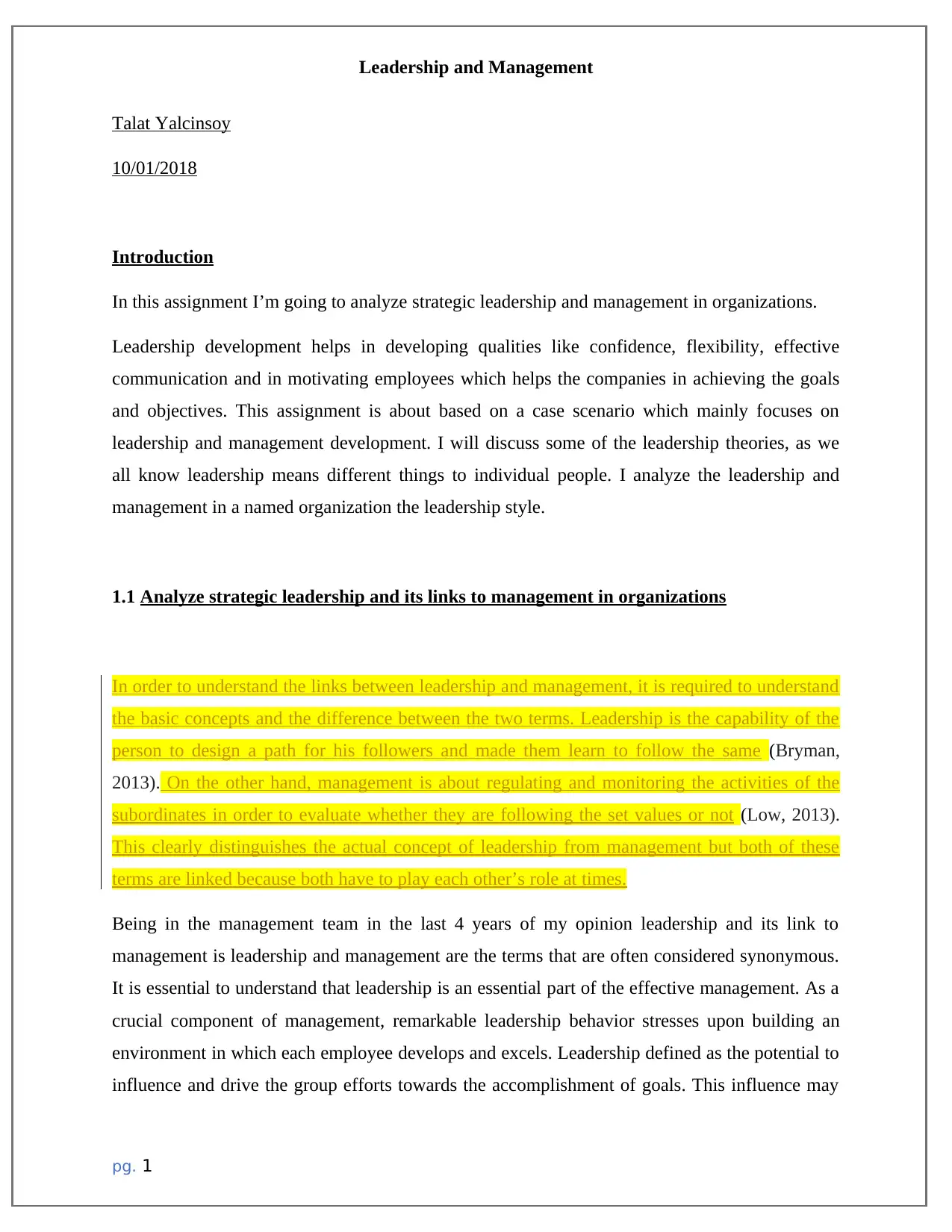
Leadership and Management
Talat Yalcinsoy
10/01/2018
Introduction
In this assignment I’m going to analyze strategic leadership and management in organizations.
Leadership development helps in developing qualities like confidence, flexibility, effective
communication and in motivating employees which helps the companies in achieving the goals
and objectives. This assignment is about based on a case scenario which mainly focuses on
leadership and management development. I will discuss some of the leadership theories, as we
all know leadership means different things to individual people. I analyze the leadership and
management in a named organization the leadership style.
1.1 Analyze strategic leadership and its links to management in organizations
In order to understand the links between leadership and management, it is required to understand
the basic concepts and the difference between the two terms. Leadership is the capability of the
person to design a path for his followers and made them learn to follow the same (Bryman,
2013). On the other hand, management is about regulating and monitoring the activities of the
subordinates in order to evaluate whether they are following the set values or not (Low, 2013).
This clearly distinguishes the actual concept of leadership from management but both of these
terms are linked because both have to play each other’s role at times.
Being in the management team in the last 4 years of my opinion leadership and its link to
management is leadership and management are the terms that are often considered synonymous.
It is essential to understand that leadership is an essential part of the effective management. As a
crucial component of management, remarkable leadership behavior stresses upon building an
environment in which each employee develops and excels. Leadership defined as the potential to
influence and drive the group efforts towards the accomplishment of goals. This influence may
pg. 1
Talat Yalcinsoy
10/01/2018
Introduction
In this assignment I’m going to analyze strategic leadership and management in organizations.
Leadership development helps in developing qualities like confidence, flexibility, effective
communication and in motivating employees which helps the companies in achieving the goals
and objectives. This assignment is about based on a case scenario which mainly focuses on
leadership and management development. I will discuss some of the leadership theories, as we
all know leadership means different things to individual people. I analyze the leadership and
management in a named organization the leadership style.
1.1 Analyze strategic leadership and its links to management in organizations
In order to understand the links between leadership and management, it is required to understand
the basic concepts and the difference between the two terms. Leadership is the capability of the
person to design a path for his followers and made them learn to follow the same (Bryman,
2013). On the other hand, management is about regulating and monitoring the activities of the
subordinates in order to evaluate whether they are following the set values or not (Low, 2013).
This clearly distinguishes the actual concept of leadership from management but both of these
terms are linked because both have to play each other’s role at times.
Being in the management team in the last 4 years of my opinion leadership and its link to
management is leadership and management are the terms that are often considered synonymous.
It is essential to understand that leadership is an essential part of the effective management. As a
crucial component of management, remarkable leadership behavior stresses upon building an
environment in which each employee develops and excels. Leadership defined as the potential to
influence and drive the group efforts towards the accomplishment of goals. This influence may
pg. 1
Paraphrase This Document
Need a fresh take? Get an instant paraphrase of this document with our AI Paraphraser
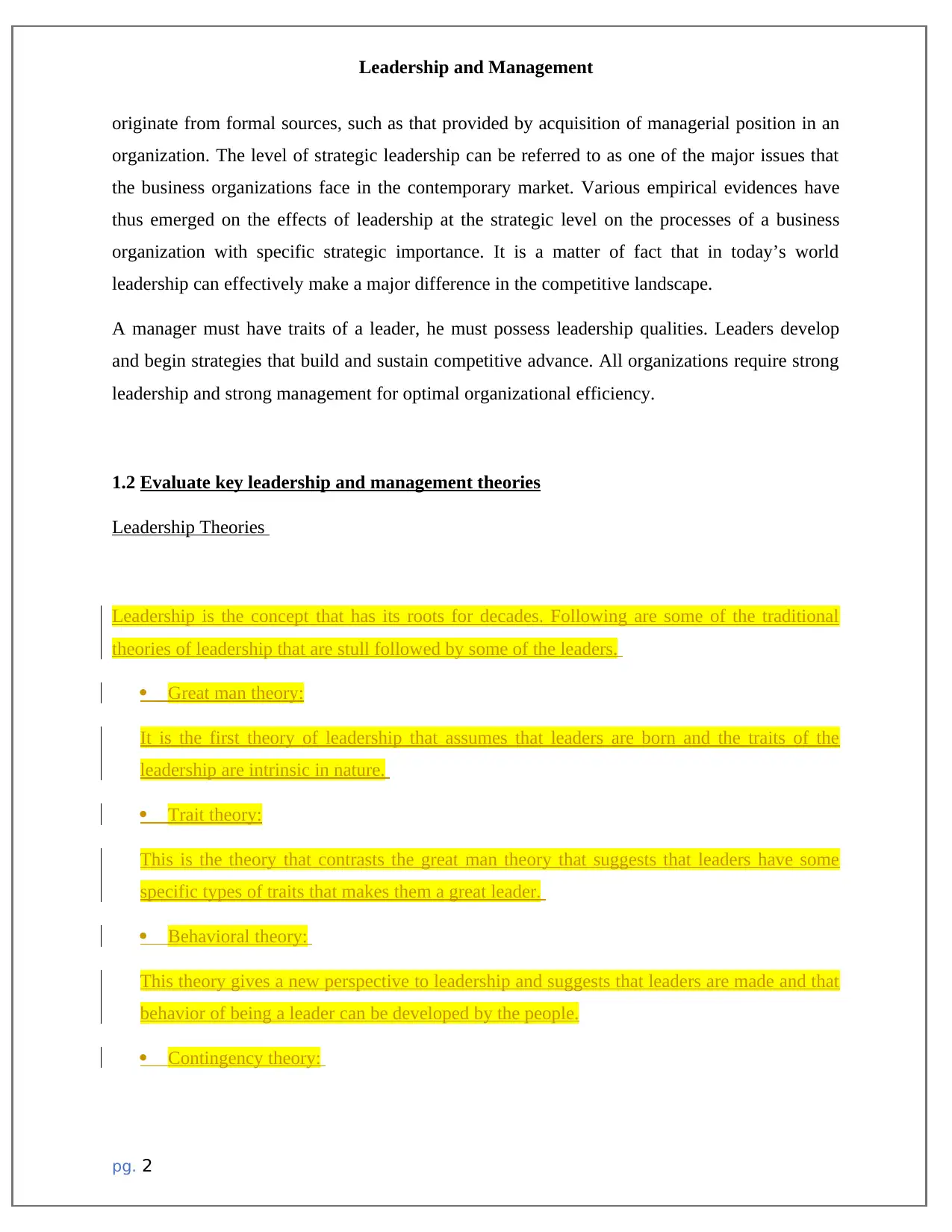
Leadership and Management
originate from formal sources, such as that provided by acquisition of managerial position in an
organization. The level of strategic leadership can be referred to as one of the major issues that
the business organizations face in the contemporary market. Various empirical evidences have
thus emerged on the effects of leadership at the strategic level on the processes of a business
organization with specific strategic importance. It is a matter of fact that in today’s world
leadership can effectively make a major difference in the competitive landscape.
A manager must have traits of a leader, he must possess leadership qualities. Leaders develop
and begin strategies that build and sustain competitive advance. All organizations require strong
leadership and strong management for optimal organizational efficiency.
1.2 Evaluate key leadership and management theories
Leadership Theories
Leadership is the concept that has its roots for decades. Following are some of the traditional
theories of leadership that are stull followed by some of the leaders.
Great man theory:
It is the first theory of leadership that assumes that leaders are born and the traits of the
leadership are intrinsic in nature.
Trait theory:
This is the theory that contrasts the great man theory that suggests that leaders have some
specific types of traits that makes them a great leader.
Behavioral theory:
This theory gives a new perspective to leadership and suggests that leaders are made and that
behavior of being a leader can be developed by the people.
Contingency theory:
pg. 2
originate from formal sources, such as that provided by acquisition of managerial position in an
organization. The level of strategic leadership can be referred to as one of the major issues that
the business organizations face in the contemporary market. Various empirical evidences have
thus emerged on the effects of leadership at the strategic level on the processes of a business
organization with specific strategic importance. It is a matter of fact that in today’s world
leadership can effectively make a major difference in the competitive landscape.
A manager must have traits of a leader, he must possess leadership qualities. Leaders develop
and begin strategies that build and sustain competitive advance. All organizations require strong
leadership and strong management for optimal organizational efficiency.
1.2 Evaluate key leadership and management theories
Leadership Theories
Leadership is the concept that has its roots for decades. Following are some of the traditional
theories of leadership that are stull followed by some of the leaders.
Great man theory:
It is the first theory of leadership that assumes that leaders are born and the traits of the
leadership are intrinsic in nature.
Trait theory:
This is the theory that contrasts the great man theory that suggests that leaders have some
specific types of traits that makes them a great leader.
Behavioral theory:
This theory gives a new perspective to leadership and suggests that leaders are made and that
behavior of being a leader can be developed by the people.
Contingency theory:
pg. 2
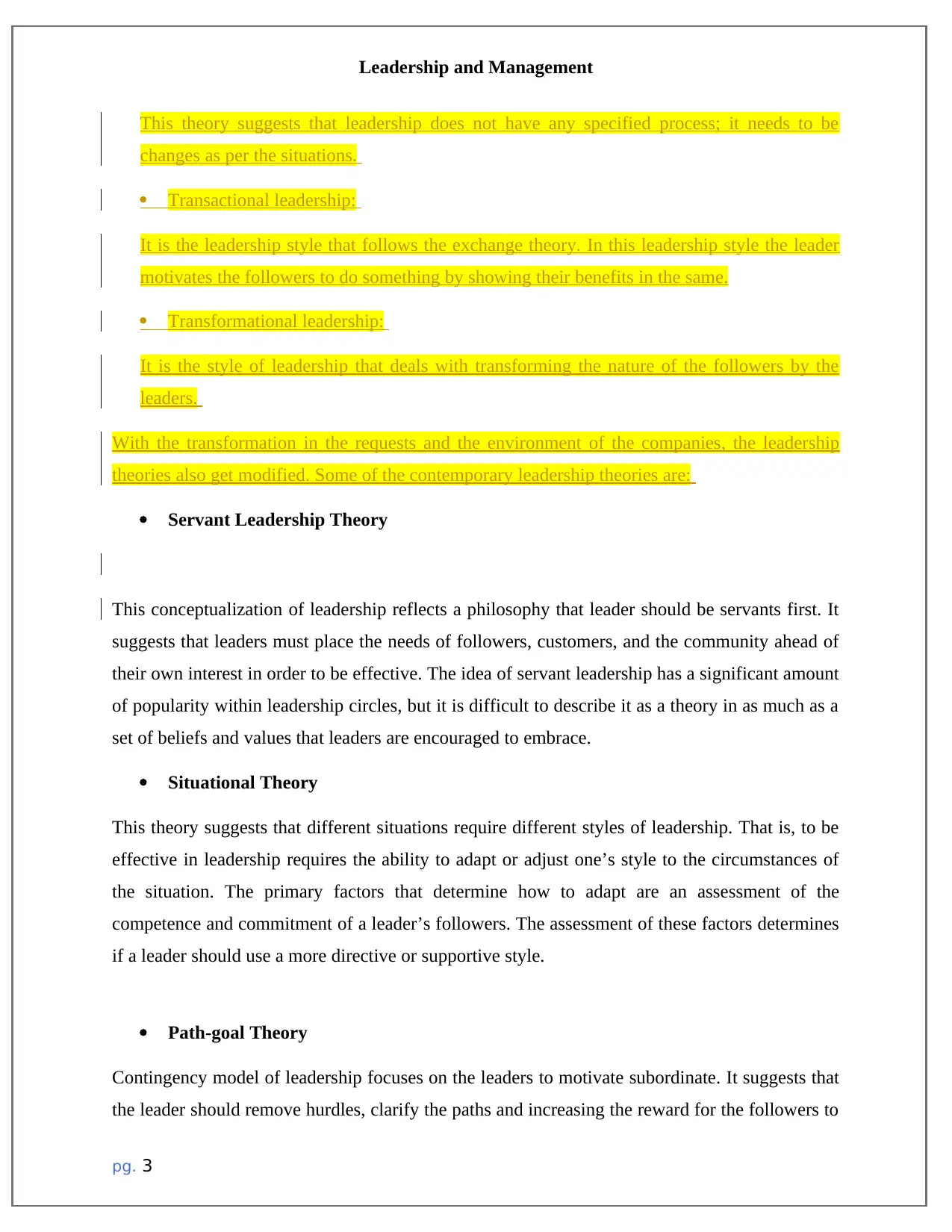
Leadership and Management
This theory suggests that leadership does not have any specified process; it needs to be
changes as per the situations.
Transactional leadership:
It is the leadership style that follows the exchange theory. In this leadership style the leader
motivates the followers to do something by showing their benefits in the same.
Transformational leadership:
It is the style of leadership that deals with transforming the nature of the followers by the
leaders.
With the transformation in the requests and the environment of the companies, the leadership
theories also get modified. Some of the contemporary leadership theories are:
Servant Leadership Theory
This conceptualization of leadership reflects a philosophy that leader should be servants first. It
suggests that leaders must place the needs of followers, customers, and the community ahead of
their own interest in order to be effective. The idea of servant leadership has a significant amount
of popularity within leadership circles, but it is difficult to describe it as a theory in as much as a
set of beliefs and values that leaders are encouraged to embrace.
Situational Theory
This theory suggests that different situations require different styles of leadership. That is, to be
effective in leadership requires the ability to adapt or adjust one’s style to the circumstances of
the situation. The primary factors that determine how to adapt are an assessment of the
competence and commitment of a leader’s followers. The assessment of these factors determines
if a leader should use a more directive or supportive style.
Path-goal Theory
Contingency model of leadership focuses on the leaders to motivate subordinate. It suggests that
the leader should remove hurdles, clarify the paths and increasing the reward for the followers to
pg. 3
This theory suggests that leadership does not have any specified process; it needs to be
changes as per the situations.
Transactional leadership:
It is the leadership style that follows the exchange theory. In this leadership style the leader
motivates the followers to do something by showing their benefits in the same.
Transformational leadership:
It is the style of leadership that deals with transforming the nature of the followers by the
leaders.
With the transformation in the requests and the environment of the companies, the leadership
theories also get modified. Some of the contemporary leadership theories are:
Servant Leadership Theory
This conceptualization of leadership reflects a philosophy that leader should be servants first. It
suggests that leaders must place the needs of followers, customers, and the community ahead of
their own interest in order to be effective. The idea of servant leadership has a significant amount
of popularity within leadership circles, but it is difficult to describe it as a theory in as much as a
set of beliefs and values that leaders are encouraged to embrace.
Situational Theory
This theory suggests that different situations require different styles of leadership. That is, to be
effective in leadership requires the ability to adapt or adjust one’s style to the circumstances of
the situation. The primary factors that determine how to adapt are an assessment of the
competence and commitment of a leader’s followers. The assessment of these factors determines
if a leader should use a more directive or supportive style.
Path-goal Theory
Contingency model of leadership focuses on the leaders to motivate subordinate. It suggests that
the leader should remove hurdles, clarify the paths and increasing the reward for the followers to
pg. 3
⊘ This is a preview!⊘
Do you want full access?
Subscribe today to unlock all pages.

Trusted by 1+ million students worldwide
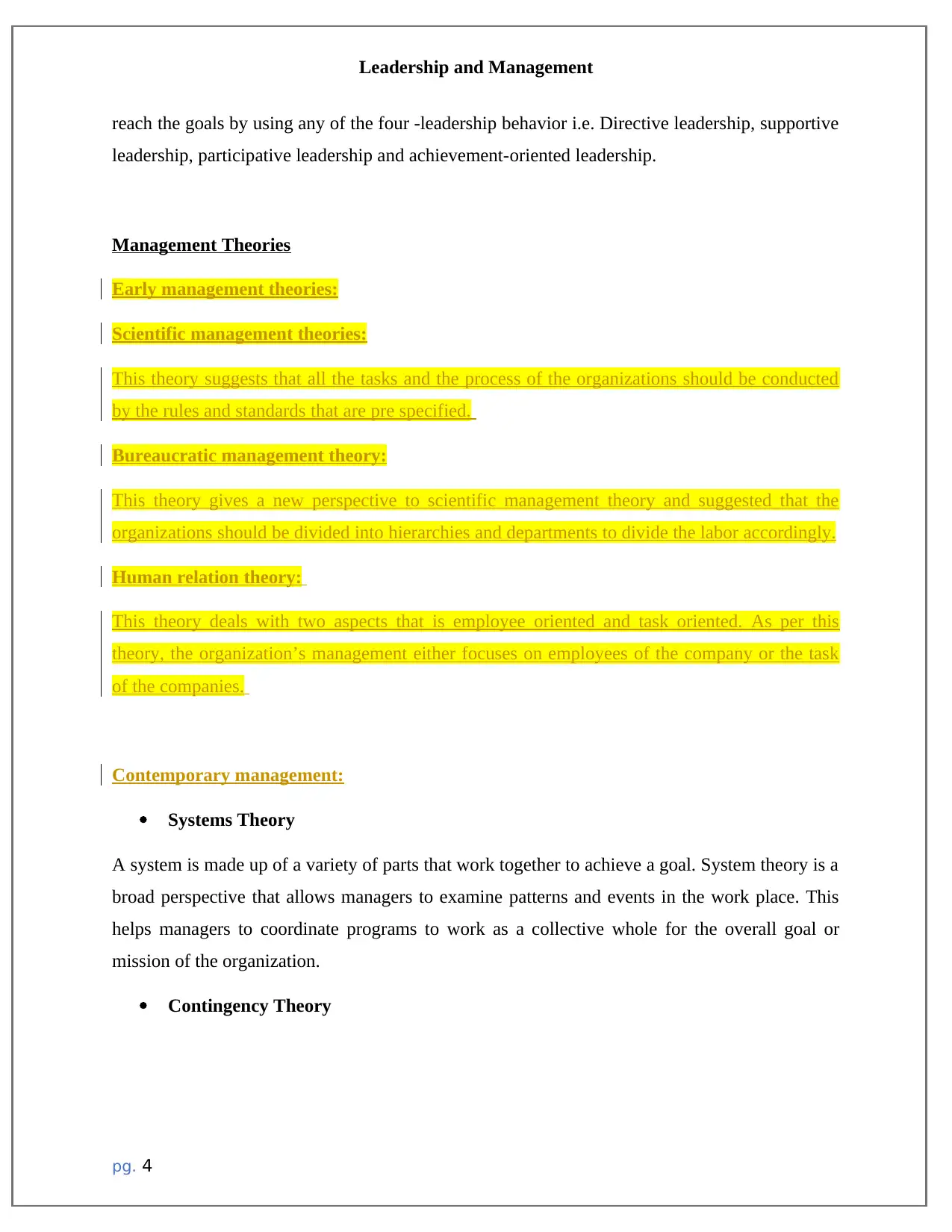
Leadership and Management
reach the goals by using any of the four -leadership behavior i.e. Directive leadership, supportive
leadership, participative leadership and achievement-oriented leadership.
Management Theories
Early management theories:
Scientific management theories:
This theory suggests that all the tasks and the process of the organizations should be conducted
by the rules and standards that are pre specified.
Bureaucratic management theory:
This theory gives a new perspective to scientific management theory and suggested that the
organizations should be divided into hierarchies and departments to divide the labor accordingly.
Human relation theory:
This theory deals with two aspects that is employee oriented and task oriented. As per this
theory, the organization’s management either focuses on employees of the company or the task
of the companies.
Contemporary management:
Systems Theory
A system is made up of a variety of parts that work together to achieve a goal. System theory is a
broad perspective that allows managers to examine patterns and events in the work place. This
helps managers to coordinate programs to work as a collective whole for the overall goal or
mission of the organization.
Contingency Theory
pg. 4
reach the goals by using any of the four -leadership behavior i.e. Directive leadership, supportive
leadership, participative leadership and achievement-oriented leadership.
Management Theories
Early management theories:
Scientific management theories:
This theory suggests that all the tasks and the process of the organizations should be conducted
by the rules and standards that are pre specified.
Bureaucratic management theory:
This theory gives a new perspective to scientific management theory and suggested that the
organizations should be divided into hierarchies and departments to divide the labor accordingly.
Human relation theory:
This theory deals with two aspects that is employee oriented and task oriented. As per this
theory, the organization’s management either focuses on employees of the company or the task
of the companies.
Contemporary management:
Systems Theory
A system is made up of a variety of parts that work together to achieve a goal. System theory is a
broad perspective that allows managers to examine patterns and events in the work place. This
helps managers to coordinate programs to work as a collective whole for the overall goal or
mission of the organization.
Contingency Theory
pg. 4
Paraphrase This Document
Need a fresh take? Get an instant paraphrase of this document with our AI Paraphraser
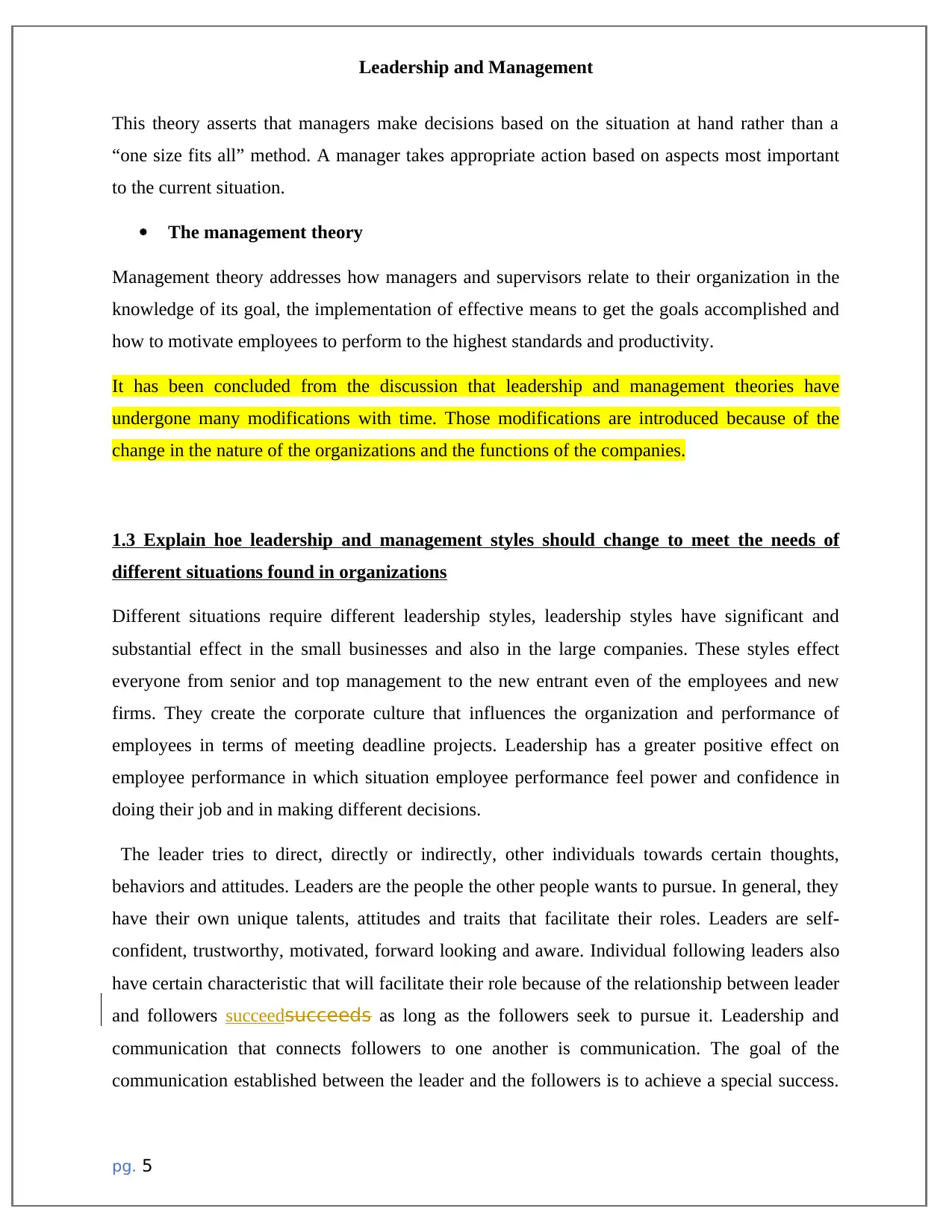
Leadership and Management
This theory asserts that managers make decisions based on the situation at hand rather than a
“one size fits all” method. A manager takes appropriate action based on aspects most important
to the current situation.
The management theory
Management theory addresses how managers and supervisors relate to their organization in the
knowledge of its goal, the implementation of effective means to get the goals accomplished and
how to motivate employees to perform to the highest standards and productivity.
It has been concluded from the discussion that leadership and management theories have
undergone many modifications with time. Those modifications are introduced because of the
change in the nature of the organizations and the functions of the companies.
1.3 Explain hoe leadership and management styles should change to meet the needs of
different situations found in organizations
Different situations require different leadership styles, leadership styles have significant and
substantial effect in the small businesses and also in the large companies. These styles effect
everyone from senior and top management to the new entrant even of the employees and new
firms. They create the corporate culture that influences the organization and performance of
employees in terms of meeting deadline projects. Leadership has a greater positive effect on
employee performance in which situation employee performance feel power and confidence in
doing their job and in making different decisions.
The leader tries to direct, directly or indirectly, other individuals towards certain thoughts,
behaviors and attitudes. Leaders are the people the other people wants to pursue. In general, they
have their own unique talents, attitudes and traits that facilitate their roles. Leaders are self-
confident, trustworthy, motivated, forward looking and aware. Individual following leaders also
have certain characteristic that will facilitate their role because of the relationship between leader
and followers succeedsucceeds as long as the followers seek to pursue it. Leadership and
communication that connects followers to one another is communication. The goal of the
communication established between the leader and the followers is to achieve a special success.
pg. 5
This theory asserts that managers make decisions based on the situation at hand rather than a
“one size fits all” method. A manager takes appropriate action based on aspects most important
to the current situation.
The management theory
Management theory addresses how managers and supervisors relate to their organization in the
knowledge of its goal, the implementation of effective means to get the goals accomplished and
how to motivate employees to perform to the highest standards and productivity.
It has been concluded from the discussion that leadership and management theories have
undergone many modifications with time. Those modifications are introduced because of the
change in the nature of the organizations and the functions of the companies.
1.3 Explain hoe leadership and management styles should change to meet the needs of
different situations found in organizations
Different situations require different leadership styles, leadership styles have significant and
substantial effect in the small businesses and also in the large companies. These styles effect
everyone from senior and top management to the new entrant even of the employees and new
firms. They create the corporate culture that influences the organization and performance of
employees in terms of meeting deadline projects. Leadership has a greater positive effect on
employee performance in which situation employee performance feel power and confidence in
doing their job and in making different decisions.
The leader tries to direct, directly or indirectly, other individuals towards certain thoughts,
behaviors and attitudes. Leaders are the people the other people wants to pursue. In general, they
have their own unique talents, attitudes and traits that facilitate their roles. Leaders are self-
confident, trustworthy, motivated, forward looking and aware. Individual following leaders also
have certain characteristic that will facilitate their role because of the relationship between leader
and followers succeedsucceeds as long as the followers seek to pursue it. Leadership and
communication that connects followers to one another is communication. The goal of the
communication established between the leader and the followers is to achieve a special success.
pg. 5
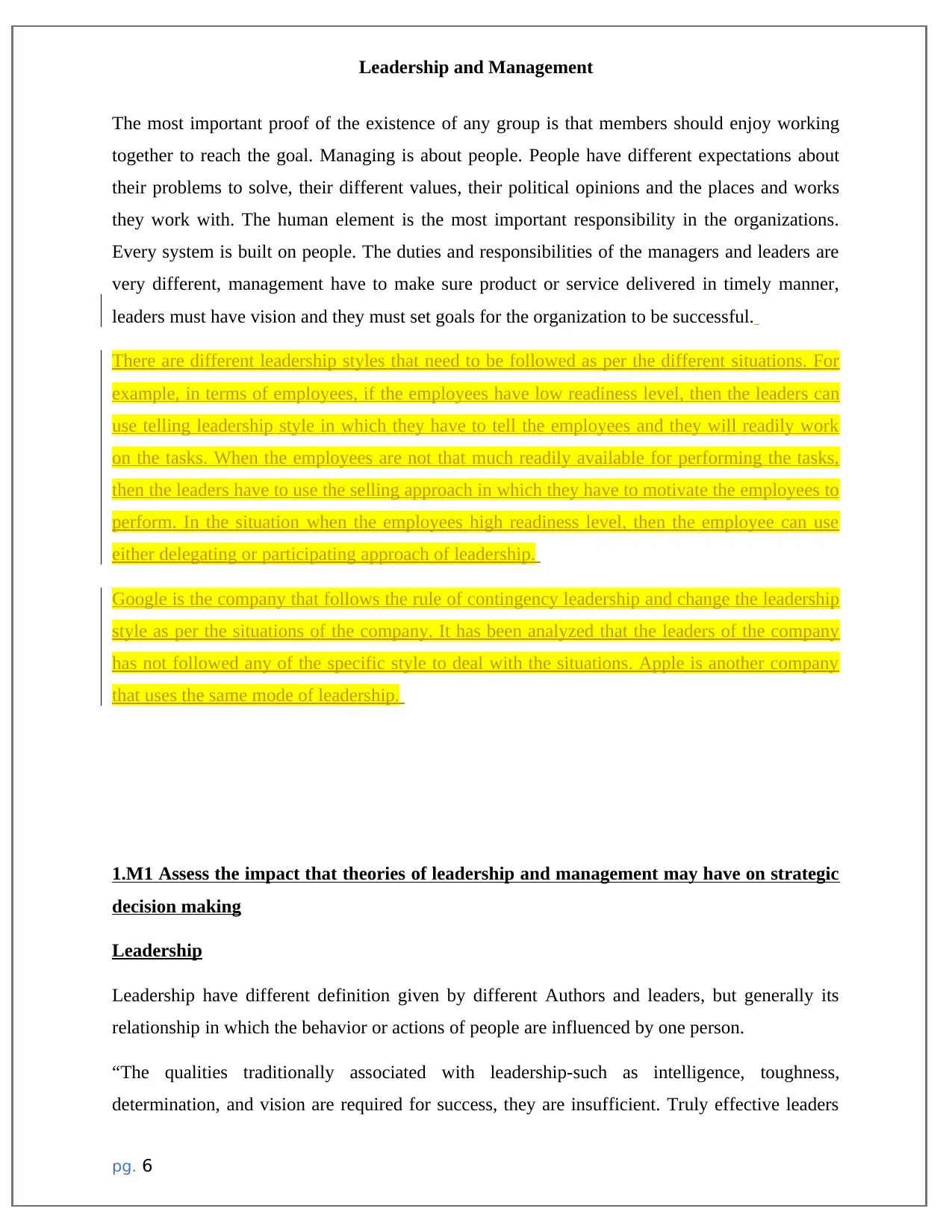
Leadership and Management
The most important proof of the existence of any group is that members should enjoy working
together to reach the goal. Managing is about people. People have different expectations about
their problems to solve, their different values, their political opinions and the places and works
they work with. The human element is the most important responsibility in the organizations.
Every system is built on people. The duties and responsibilities of the managers and leaders are
very different, management have to make sure product or service delivered in timely manner,
leaders must have vision and they must set goals for the organization to be successful.
There are different leadership styles that need to be followed as per the different situations. For
example, in terms of employees, if the employees have low readiness level, then the leaders can
use telling leadership style in which they have to tell the employees and they will readily work
on the tasks. When the employees are not that much readily available for performing the tasks,
then the leaders have to use the selling approach in which they have to motivate the employees to
perform. In the situation when the employees high readiness level, then the employee can use
either delegating or participating approach of leadership.
Google is the company that follows the rule of contingency leadership and change the leadership
style as per the situations of the company. It has been analyzed that the leaders of the company
has not followed any of the specific style to deal with the situations. Apple is another company
that uses the same mode of leadership.
1.M1 Assess the impact that theories of leadership and management may have on strategic
decision making
Leadership
Leadership have different definition given by different Authors and leaders, but generally its
relationship in which the behavior or actions of people are influenced by one person.
“The qualities traditionally associated with leadership-such as intelligence, toughness,
determination, and vision are required for success, they are insufficient. Truly effective leaders
pg. 6
The most important proof of the existence of any group is that members should enjoy working
together to reach the goal. Managing is about people. People have different expectations about
their problems to solve, their different values, their political opinions and the places and works
they work with. The human element is the most important responsibility in the organizations.
Every system is built on people. The duties and responsibilities of the managers and leaders are
very different, management have to make sure product or service delivered in timely manner,
leaders must have vision and they must set goals for the organization to be successful.
There are different leadership styles that need to be followed as per the different situations. For
example, in terms of employees, if the employees have low readiness level, then the leaders can
use telling leadership style in which they have to tell the employees and they will readily work
on the tasks. When the employees are not that much readily available for performing the tasks,
then the leaders have to use the selling approach in which they have to motivate the employees to
perform. In the situation when the employees high readiness level, then the employee can use
either delegating or participating approach of leadership.
Google is the company that follows the rule of contingency leadership and change the leadership
style as per the situations of the company. It has been analyzed that the leaders of the company
has not followed any of the specific style to deal with the situations. Apple is another company
that uses the same mode of leadership.
1.M1 Assess the impact that theories of leadership and management may have on strategic
decision making
Leadership
Leadership have different definition given by different Authors and leaders, but generally its
relationship in which the behavior or actions of people are influenced by one person.
“The qualities traditionally associated with leadership-such as intelligence, toughness,
determination, and vision are required for success, they are insufficient. Truly effective leaders
pg. 6
⊘ This is a preview!⊘
Do you want full access?
Subscribe today to unlock all pages.

Trusted by 1+ million students worldwide
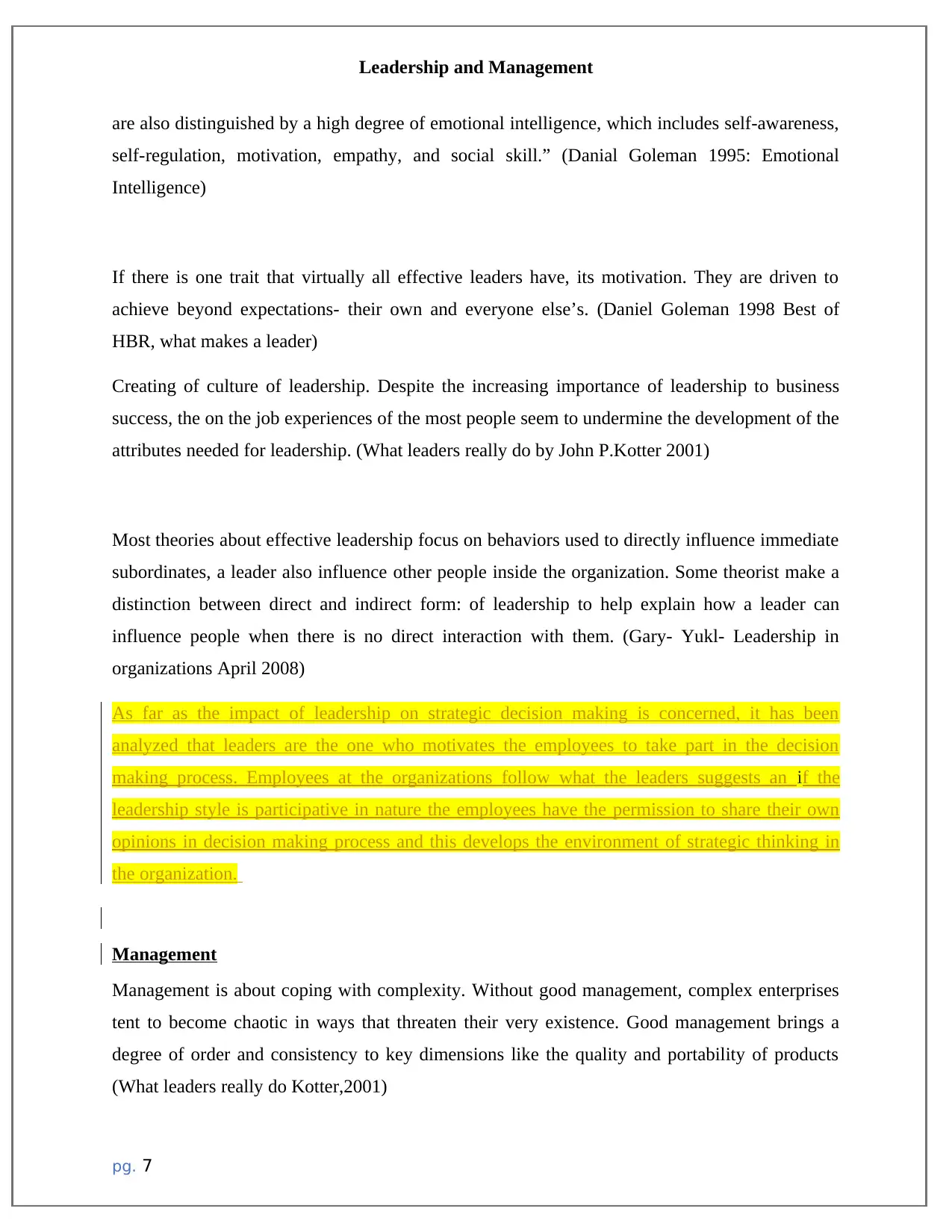
Leadership and Management
are also distinguished by a high degree of emotional intelligence, which includes self-awareness,
self-regulation, motivation, empathy, and social skill.” (Danial Goleman 1995: Emotional
Intelligence)
If there is one trait that virtually all effective leaders have, its motivation. They are driven to
achieve beyond expectations- their own and everyone else’s. (Daniel Goleman 1998 Best of
HBR, what makes a leader)
Creating of culture of leadership. Despite the increasing importance of leadership to business
success, the on the job experiences of the most people seem to undermine the development of the
attributes needed for leadership. (What leaders really do by John P.Kotter 2001)
Most theories about effective leadership focus on behaviors used to directly influence immediate
subordinates, a leader also influence other people inside the organization. Some theorist make a
distinction between direct and indirect form: of leadership to help explain how a leader can
influence people when there is no direct interaction with them. (Gary- Yukl- Leadership in
organizations April 2008)
As far as the impact of leadership on strategic decision making is concerned, it has been
analyzed that leaders are the one who motivates the employees to take part in the decision
making process. Employees at the organizations follow what the leaders suggests an if the
leadership style is participative in nature the employees have the permission to share their own
opinions in decision making process and this develops the environment of strategic thinking in
the organization.
Management
Management is about coping with complexity. Without good management, complex enterprises
tent to become chaotic in ways that threaten their very existence. Good management brings a
degree of order and consistency to key dimensions like the quality and portability of products
(What leaders really do Kotter,2001)
pg. 7
are also distinguished by a high degree of emotional intelligence, which includes self-awareness,
self-regulation, motivation, empathy, and social skill.” (Danial Goleman 1995: Emotional
Intelligence)
If there is one trait that virtually all effective leaders have, its motivation. They are driven to
achieve beyond expectations- their own and everyone else’s. (Daniel Goleman 1998 Best of
HBR, what makes a leader)
Creating of culture of leadership. Despite the increasing importance of leadership to business
success, the on the job experiences of the most people seem to undermine the development of the
attributes needed for leadership. (What leaders really do by John P.Kotter 2001)
Most theories about effective leadership focus on behaviors used to directly influence immediate
subordinates, a leader also influence other people inside the organization. Some theorist make a
distinction between direct and indirect form: of leadership to help explain how a leader can
influence people when there is no direct interaction with them. (Gary- Yukl- Leadership in
organizations April 2008)
As far as the impact of leadership on strategic decision making is concerned, it has been
analyzed that leaders are the one who motivates the employees to take part in the decision
making process. Employees at the organizations follow what the leaders suggests an if the
leadership style is participative in nature the employees have the permission to share their own
opinions in decision making process and this develops the environment of strategic thinking in
the organization.
Management
Management is about coping with complexity. Without good management, complex enterprises
tent to become chaotic in ways that threaten their very existence. Good management brings a
degree of order and consistency to key dimensions like the quality and portability of products
(What leaders really do Kotter,2001)
pg. 7
Paraphrase This Document
Need a fresh take? Get an instant paraphrase of this document with our AI Paraphraser
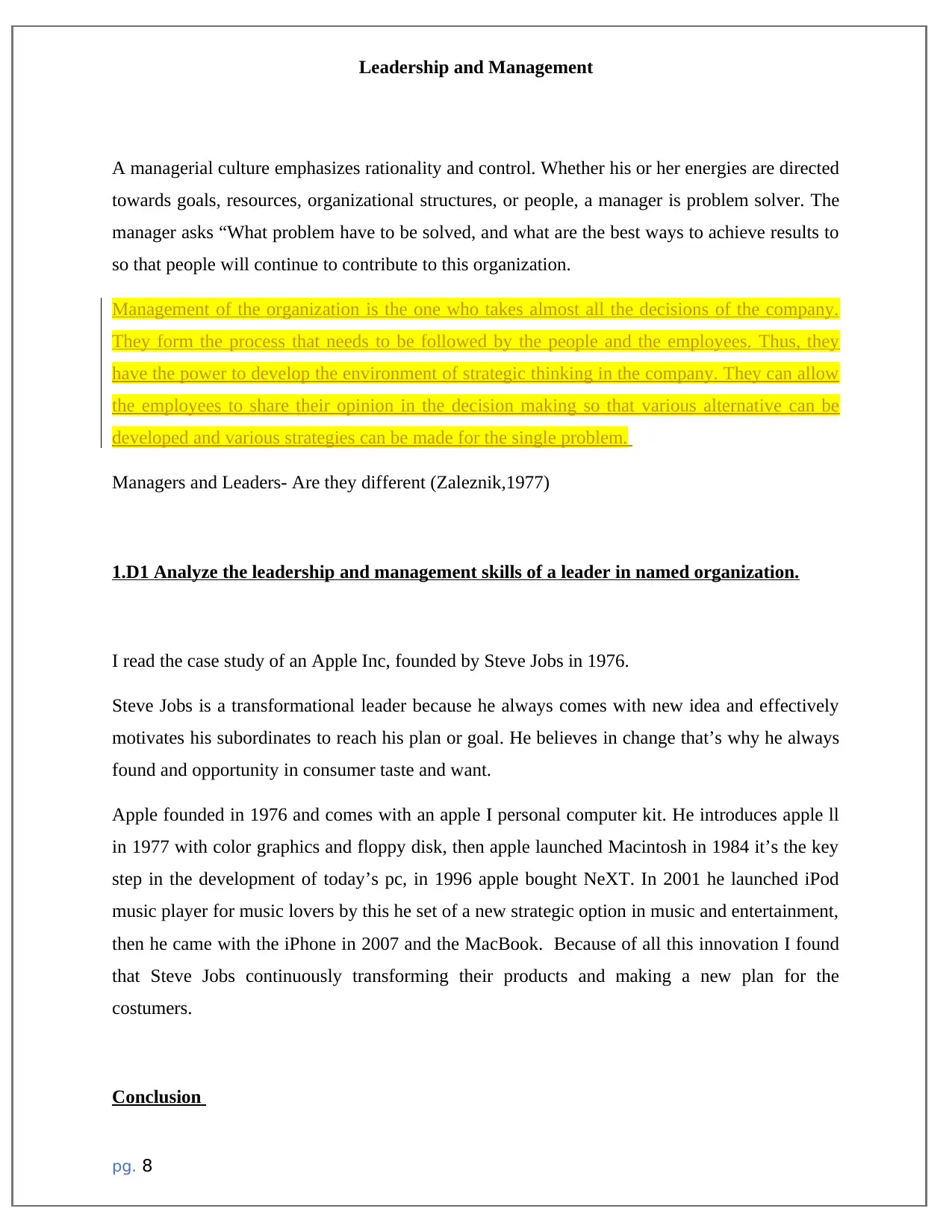
Leadership and Management
A managerial culture emphasizes rationality and control. Whether his or her energies are directed
towards goals, resources, organizational structures, or people, a manager is problem solver. The
manager asks “What problem have to be solved, and what are the best ways to achieve results to
so that people will continue to contribute to this organization.
Management of the organization is the one who takes almost all the decisions of the company.
They form the process that needs to be followed by the people and the employees. Thus, they
have the power to develop the environment of strategic thinking in the company. They can allow
the employees to share their opinion in the decision making so that various alternative can be
developed and various strategies can be made for the single problem.
Managers and Leaders- Are they different (Zaleznik,1977)
1.D1 Analyze the leadership and management skills of a leader in named organization.
I read the case study of an Apple Inc, founded by Steve Jobs in 1976.
Steve Jobs is a transformational leader because he always comes with new idea and effectively
motivates his subordinates to reach his plan or goal. He believes in change that’s why he always
found and opportunity in consumer taste and want.
Apple founded in 1976 and comes with an apple I personal computer kit. He introduces apple ll
in 1977 with color graphics and floppy disk, then apple launched Macintosh in 1984 it’s the key
step in the development of today’s pc, in 1996 apple bought NeXT. In 2001 he launched iPod
music player for music lovers by this he set of a new strategic option in music and entertainment,
then he came with the iPhone in 2007 and the MacBook. Because of all this innovation I found
that Steve Jobs continuously transforming their products and making a new plan for the
costumers.
Conclusion
pg. 8
A managerial culture emphasizes rationality and control. Whether his or her energies are directed
towards goals, resources, organizational structures, or people, a manager is problem solver. The
manager asks “What problem have to be solved, and what are the best ways to achieve results to
so that people will continue to contribute to this organization.
Management of the organization is the one who takes almost all the decisions of the company.
They form the process that needs to be followed by the people and the employees. Thus, they
have the power to develop the environment of strategic thinking in the company. They can allow
the employees to share their opinion in the decision making so that various alternative can be
developed and various strategies can be made for the single problem.
Managers and Leaders- Are they different (Zaleznik,1977)
1.D1 Analyze the leadership and management skills of a leader in named organization.
I read the case study of an Apple Inc, founded by Steve Jobs in 1976.
Steve Jobs is a transformational leader because he always comes with new idea and effectively
motivates his subordinates to reach his plan or goal. He believes in change that’s why he always
found and opportunity in consumer taste and want.
Apple founded in 1976 and comes with an apple I personal computer kit. He introduces apple ll
in 1977 with color graphics and floppy disk, then apple launched Macintosh in 1984 it’s the key
step in the development of today’s pc, in 1996 apple bought NeXT. In 2001 he launched iPod
music player for music lovers by this he set of a new strategic option in music and entertainment,
then he came with the iPhone in 2007 and the MacBook. Because of all this innovation I found
that Steve Jobs continuously transforming their products and making a new plan for the
costumers.
Conclusion
pg. 8
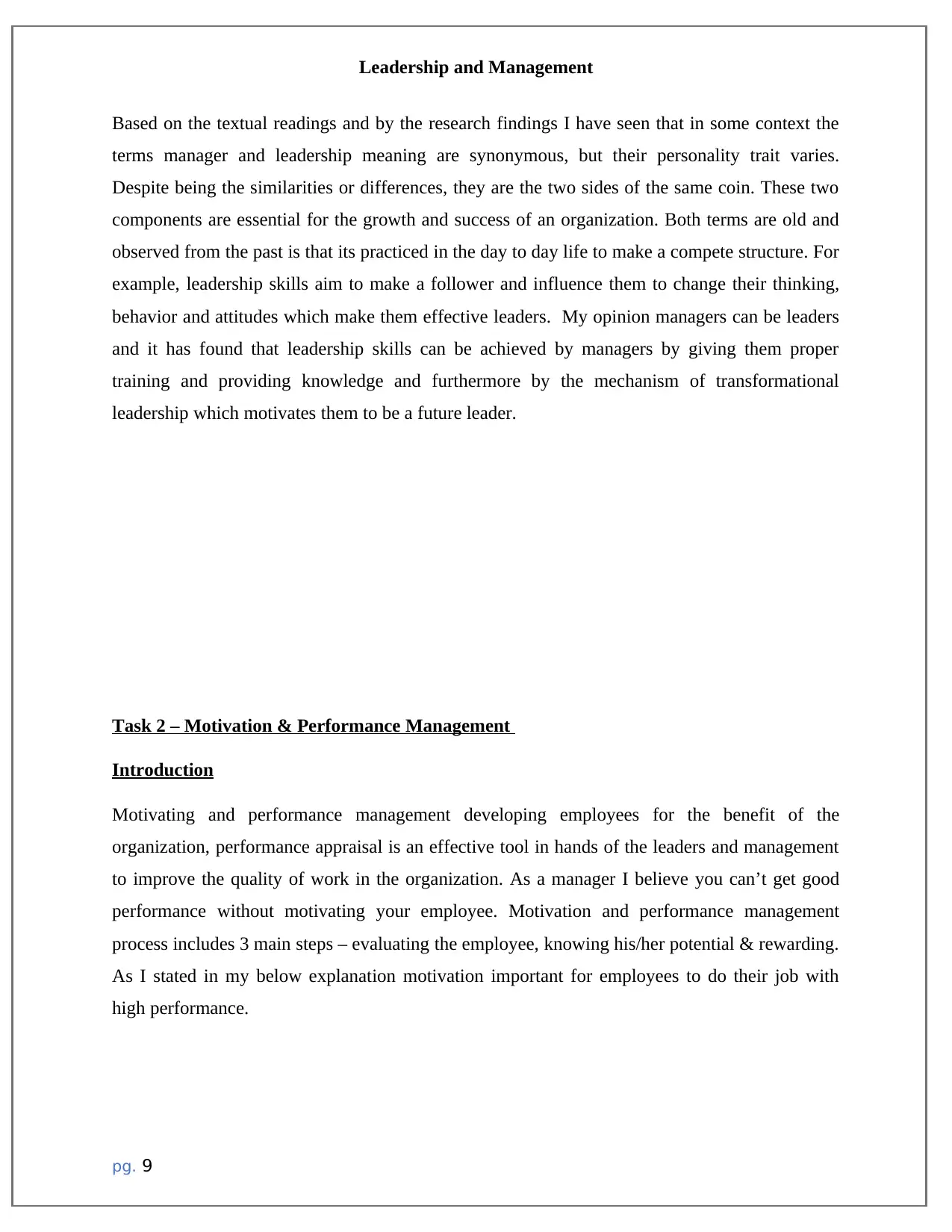
Leadership and Management
Based on the textual readings and by the research findings I have seen that in some context the
terms manager and leadership meaning are synonymous, but their personality trait varies.
Despite being the similarities or differences, they are the two sides of the same coin. These two
components are essential for the growth and success of an organization. Both terms are old and
observed from the past is that its practiced in the day to day life to make a compete structure. For
example, leadership skills aim to make a follower and influence them to change their thinking,
behavior and attitudes which make them effective leaders. My opinion managers can be leaders
and it has found that leadership skills can be achieved by managers by giving them proper
training and providing knowledge and furthermore by the mechanism of transformational
leadership which motivates them to be a future leader.
Task 2 – Motivation & Performance Management
Introduction
Motivating and performance management developing employees for the benefit of the
organization, performance appraisal is an effective tool in hands of the leaders and management
to improve the quality of work in the organization. As a manager I believe you can’t get good
performance without motivating your employee. Motivation and performance management
process includes 3 main steps – evaluating the employee, knowing his/her potential & rewarding.
As I stated in my below explanation motivation important for employees to do their job with
high performance.
pg. 9
Based on the textual readings and by the research findings I have seen that in some context the
terms manager and leadership meaning are synonymous, but their personality trait varies.
Despite being the similarities or differences, they are the two sides of the same coin. These two
components are essential for the growth and success of an organization. Both terms are old and
observed from the past is that its practiced in the day to day life to make a compete structure. For
example, leadership skills aim to make a follower and influence them to change their thinking,
behavior and attitudes which make them effective leaders. My opinion managers can be leaders
and it has found that leadership skills can be achieved by managers by giving them proper
training and providing knowledge and furthermore by the mechanism of transformational
leadership which motivates them to be a future leader.
Task 2 – Motivation & Performance Management
Introduction
Motivating and performance management developing employees for the benefit of the
organization, performance appraisal is an effective tool in hands of the leaders and management
to improve the quality of work in the organization. As a manager I believe you can’t get good
performance without motivating your employee. Motivation and performance management
process includes 3 main steps – evaluating the employee, knowing his/her potential & rewarding.
As I stated in my below explanation motivation important for employees to do their job with
high performance.
pg. 9
⊘ This is a preview!⊘
Do you want full access?
Subscribe today to unlock all pages.

Trusted by 1+ million students worldwide
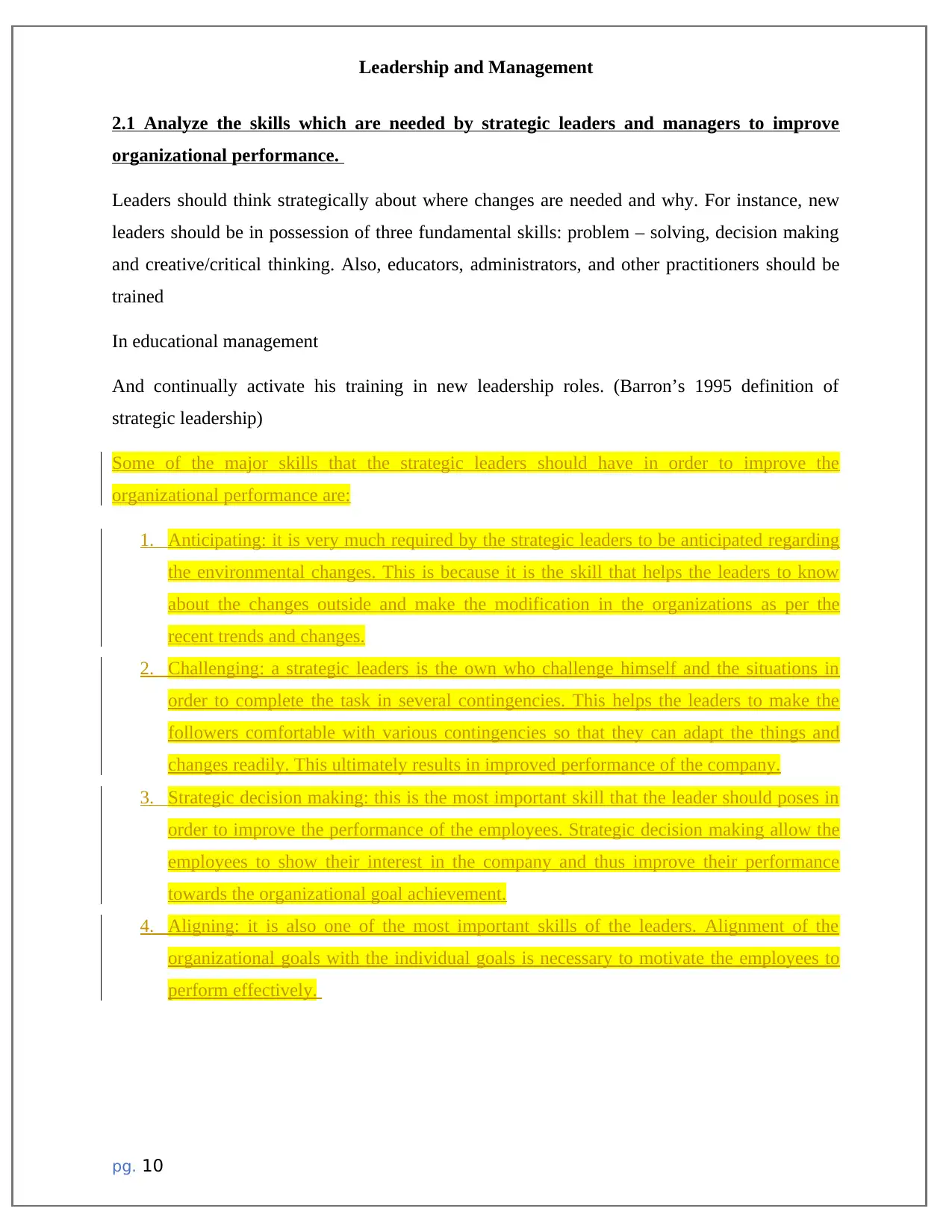
Leadership and Management
2.1 Analyze the skills which are needed by strategic leaders and managers to improve
organizational performance.
Leaders should think strategically about where changes are needed and why. For instance, new
leaders should be in possession of three fundamental skills: problem – solving, decision making
and creative/critical thinking. Also, educators, administrators, and other practitioners should be
trained
In educational management
And continually activate his training in new leadership roles. (Barron’s 1995 definition of
strategic leadership)
Some of the major skills that the strategic leaders should have in order to improve the
organizational performance are:
1. Anticipating: it is very much required by the strategic leaders to be anticipated regarding
the environmental changes. This is because it is the skill that helps the leaders to know
about the changes outside and make the modification in the organizations as per the
recent trends and changes.
2. Challenging: a strategic leaders is the own who challenge himself and the situations in
order to complete the task in several contingencies. This helps the leaders to make the
followers comfortable with various contingencies so that they can adapt the things and
changes readily. This ultimately results in improved performance of the company.
3. Strategic decision making: this is the most important skill that the leader should poses in
order to improve the performance of the employees. Strategic decision making allow the
employees to show their interest in the company and thus improve their performance
towards the organizational goal achievement.
4. Aligning: it is also one of the most important skills of the leaders. Alignment of the
organizational goals with the individual goals is necessary to motivate the employees to
perform effectively.
pg. 10
2.1 Analyze the skills which are needed by strategic leaders and managers to improve
organizational performance.
Leaders should think strategically about where changes are needed and why. For instance, new
leaders should be in possession of three fundamental skills: problem – solving, decision making
and creative/critical thinking. Also, educators, administrators, and other practitioners should be
trained
In educational management
And continually activate his training in new leadership roles. (Barron’s 1995 definition of
strategic leadership)
Some of the major skills that the strategic leaders should have in order to improve the
organizational performance are:
1. Anticipating: it is very much required by the strategic leaders to be anticipated regarding
the environmental changes. This is because it is the skill that helps the leaders to know
about the changes outside and make the modification in the organizations as per the
recent trends and changes.
2. Challenging: a strategic leaders is the own who challenge himself and the situations in
order to complete the task in several contingencies. This helps the leaders to make the
followers comfortable with various contingencies so that they can adapt the things and
changes readily. This ultimately results in improved performance of the company.
3. Strategic decision making: this is the most important skill that the leader should poses in
order to improve the performance of the employees. Strategic decision making allow the
employees to show their interest in the company and thus improve their performance
towards the organizational goal achievement.
4. Aligning: it is also one of the most important skills of the leaders. Alignment of the
organizational goals with the individual goals is necessary to motivate the employees to
perform effectively.
pg. 10
Paraphrase This Document
Need a fresh take? Get an instant paraphrase of this document with our AI Paraphraser
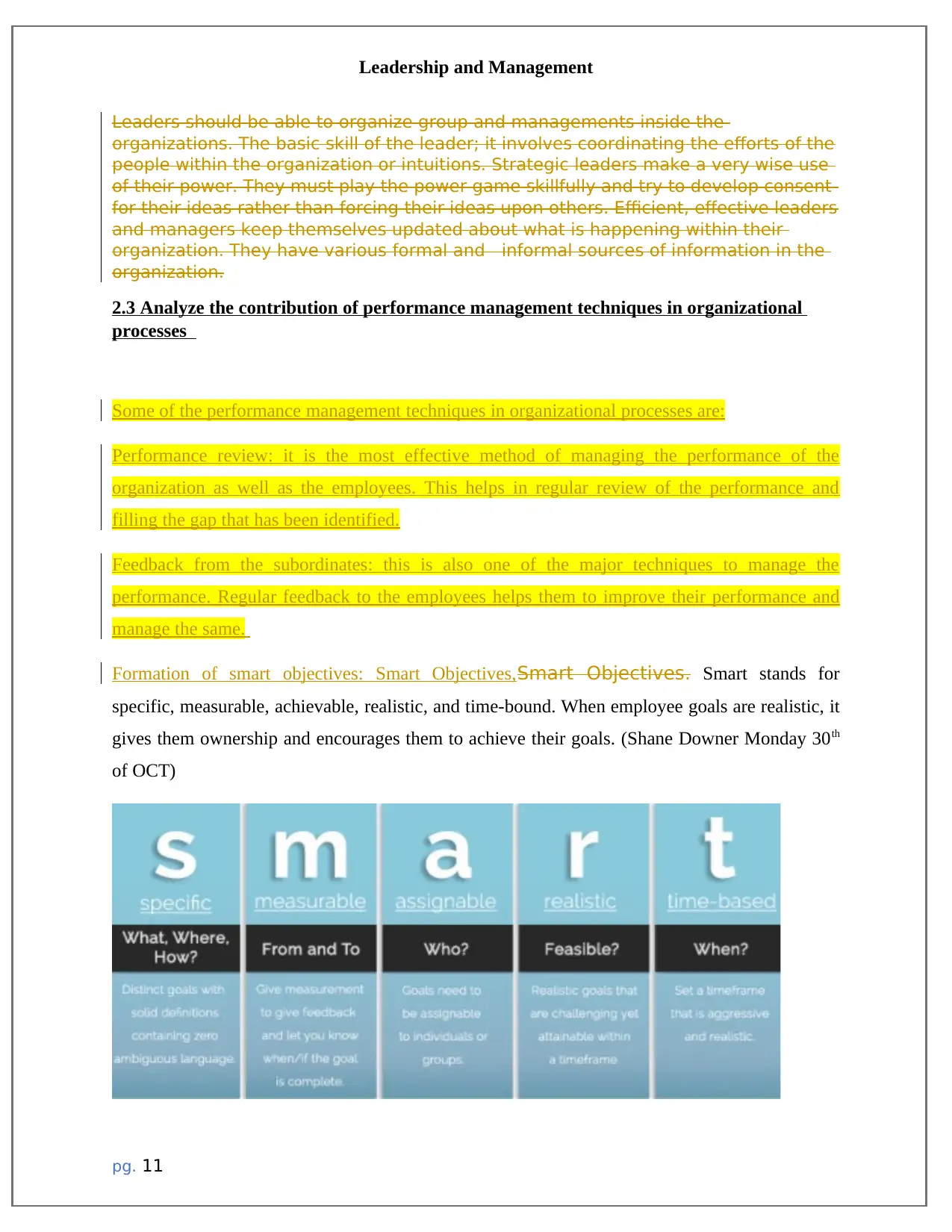
Leadership and Management
Leaders should be able to organize group and managements inside the
organizations. The basic skill of the leader; it involves coordinating the efforts of the
people within the organization or intuitions. Strategic leaders make a very wise use
of their power. They must play the power game skillfully and try to develop consent
for their ideas rather than forcing their ideas upon others. Efficient, effective leaders
and managers keep themselves updated about what is happening within their
organization. They have various formal and informal sources of information in the
organization.
2.3 Analyze the contribution of performance management techniques in organizational
processes
Some of the performance management techniques in organizational processes are:
Performance review: it is the most effective method of managing the performance of the
organization as well as the employees. This helps in regular review of the performance and
filling the gap that has been identified.
Feedback from the subordinates: this is also one of the major techniques to manage the
performance. Regular feedback to the employees helps them to improve their performance and
manage the same.
Formation of smart objectives: Smart Objectives,Smart Objectives. Smart stands for
specific, measurable, achievable, realistic, and time-bound. When employee goals are realistic, it
gives them ownership and encourages them to achieve their goals. (Shane Downer Monday 30th
of OCT)
pg. 11
Leaders should be able to organize group and managements inside the
organizations. The basic skill of the leader; it involves coordinating the efforts of the
people within the organization or intuitions. Strategic leaders make a very wise use
of their power. They must play the power game skillfully and try to develop consent
for their ideas rather than forcing their ideas upon others. Efficient, effective leaders
and managers keep themselves updated about what is happening within their
organization. They have various formal and informal sources of information in the
organization.
2.3 Analyze the contribution of performance management techniques in organizational
processes
Some of the performance management techniques in organizational processes are:
Performance review: it is the most effective method of managing the performance of the
organization as well as the employees. This helps in regular review of the performance and
filling the gap that has been identified.
Feedback from the subordinates: this is also one of the major techniques to manage the
performance. Regular feedback to the employees helps them to improve their performance and
manage the same.
Formation of smart objectives: Smart Objectives,Smart Objectives. Smart stands for
specific, measurable, achievable, realistic, and time-bound. When employee goals are realistic, it
gives them ownership and encourages them to achieve their goals. (Shane Downer Monday 30th
of OCT)
pg. 11
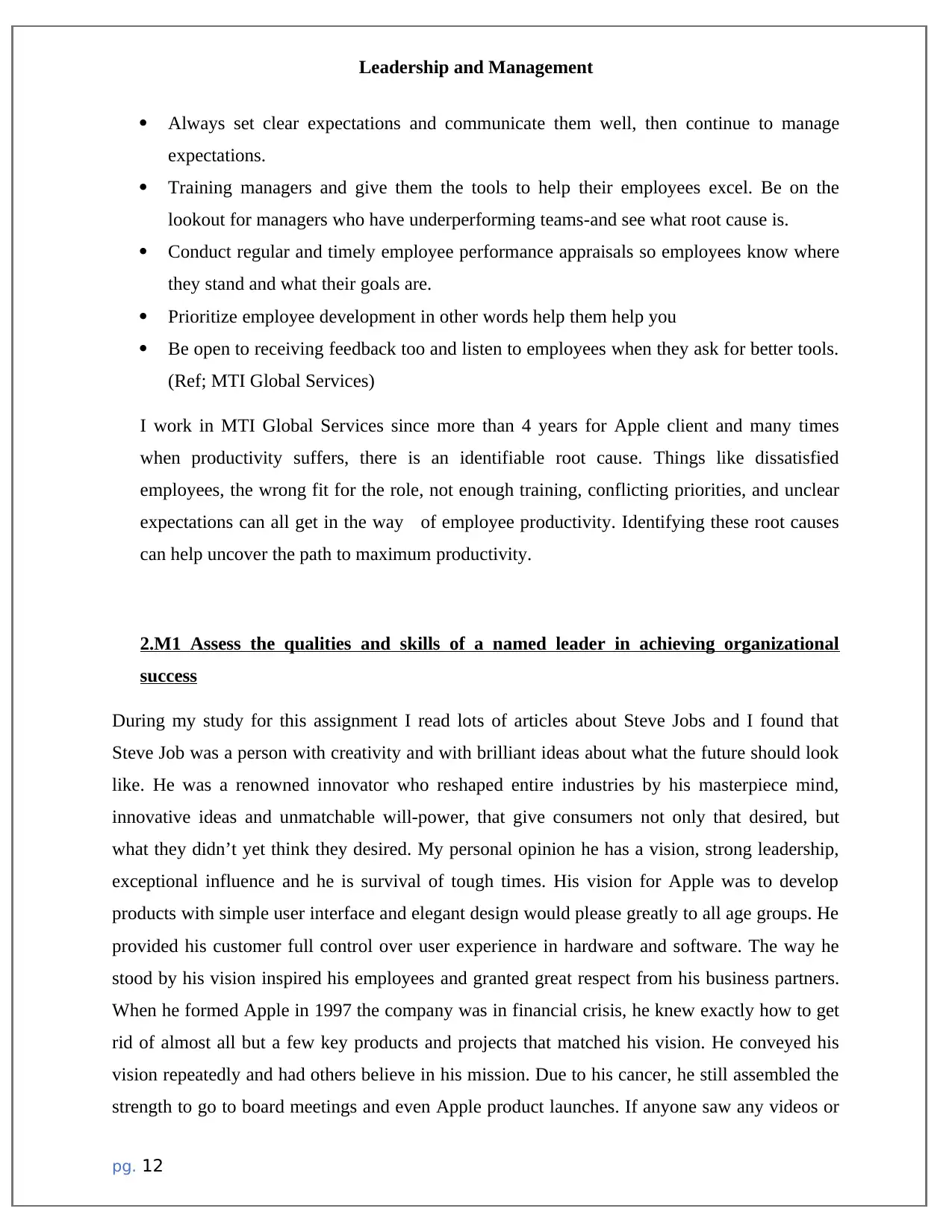
Leadership and Management
Always set clear expectations and communicate them well, then continue to manage
expectations.
Training managers and give them the tools to help their employees excel. Be on the
lookout for managers who have underperforming teams-and see what root cause is.
Conduct regular and timely employee performance appraisals so employees know where
they stand and what their goals are.
Prioritize employee development in other words help them help you
Be open to receiving feedback too and listen to employees when they ask for better tools.
(Ref; MTI Global Services)
I work in MTI Global Services since more than 4 years for Apple client and many times
when productivity suffers, there is an identifiable root cause. Things like dissatisfied
employees, the wrong fit for the role, not enough training, conflicting priorities, and unclear
expectations can all get in the way of employee productivity. Identifying these root causes
can help uncover the path to maximum productivity.
2.M1 Assess the qualities and skills of a named leader in achieving organizational
success
During my study for this assignment I read lots of articles about Steve Jobs and I found that
Steve Job was a person with creativity and with brilliant ideas about what the future should look
like. He was a renowned innovator who reshaped entire industries by his masterpiece mind,
innovative ideas and unmatchable will-power, that give consumers not only that desired, but
what they didn’t yet think they desired. My personal opinion he has a vision, strong leadership,
exceptional influence and he is survival of tough times. His vision for Apple was to develop
products with simple user interface and elegant design would please greatly to all age groups. He
provided his customer full control over user experience in hardware and software. The way he
stood by his vision inspired his employees and granted great respect from his business partners.
When he formed Apple in 1997 the company was in financial crisis, he knew exactly how to get
rid of almost all but a few key products and projects that matched his vision. He conveyed his
vision repeatedly and had others believe in his mission. Due to his cancer, he still assembled the
strength to go to board meetings and even Apple product launches. If anyone saw any videos or
pg. 12
Always set clear expectations and communicate them well, then continue to manage
expectations.
Training managers and give them the tools to help their employees excel. Be on the
lookout for managers who have underperforming teams-and see what root cause is.
Conduct regular and timely employee performance appraisals so employees know where
they stand and what their goals are.
Prioritize employee development in other words help them help you
Be open to receiving feedback too and listen to employees when they ask for better tools.
(Ref; MTI Global Services)
I work in MTI Global Services since more than 4 years for Apple client and many times
when productivity suffers, there is an identifiable root cause. Things like dissatisfied
employees, the wrong fit for the role, not enough training, conflicting priorities, and unclear
expectations can all get in the way of employee productivity. Identifying these root causes
can help uncover the path to maximum productivity.
2.M1 Assess the qualities and skills of a named leader in achieving organizational
success
During my study for this assignment I read lots of articles about Steve Jobs and I found that
Steve Job was a person with creativity and with brilliant ideas about what the future should look
like. He was a renowned innovator who reshaped entire industries by his masterpiece mind,
innovative ideas and unmatchable will-power, that give consumers not only that desired, but
what they didn’t yet think they desired. My personal opinion he has a vision, strong leadership,
exceptional influence and he is survival of tough times. His vision for Apple was to develop
products with simple user interface and elegant design would please greatly to all age groups. He
provided his customer full control over user experience in hardware and software. The way he
stood by his vision inspired his employees and granted great respect from his business partners.
When he formed Apple in 1997 the company was in financial crisis, he knew exactly how to get
rid of almost all but a few key products and projects that matched his vision. He conveyed his
vision repeatedly and had others believe in his mission. Due to his cancer, he still assembled the
strength to go to board meetings and even Apple product launches. If anyone saw any videos or
pg. 12
⊘ This is a preview!⊘
Do you want full access?
Subscribe today to unlock all pages.

Trusted by 1+ million students worldwide
1 out of 29
Related Documents
Your All-in-One AI-Powered Toolkit for Academic Success.
+13062052269
info@desklib.com
Available 24*7 on WhatsApp / Email
![[object Object]](/_next/static/media/star-bottom.7253800d.svg)
Unlock your academic potential
Copyright © 2020–2025 A2Z Services. All Rights Reserved. Developed and managed by ZUCOL.





